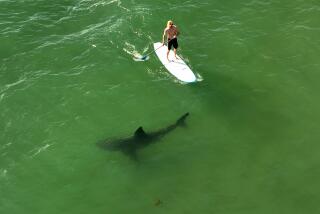40 Years of Cooperation : Navy, Scripps Enjoy Research Partnership
LA JOLLA — Anyone wanting to locate an object in the vast reaches of the world’s oceans would likely build on work done at the renowned Scripps Institution of Oceanography, home to many of the world’s foremost underwater acoustical researchers.
And there is no one who needs to locate more things in more oceans than the U.S. Navy.
So although fishing vessels and the Merchant Marine can sometimes take advantage of sonar--or other oceanographic advances--the biggest beneficiary of basic ocean research is likely to be the ocean’s biggest user.
For that reason, Scripps--and the field of American oceanography in general--has enjoyed a 40-year relationship with the Navy that is unique among those between the military and the nation’s universities. Ocean studies, whether dealing in underwater sound propagation, detection of chemicals in water or the distribution of plankton, owe much of their existence to funding from the U.S. Navy. And historically, the Navy has responded positively to requests by university researchers for money for basic science research, even when the work has only minimal, and often unclear, relationships to ongoing or potential military uses.
Today, the Navy accounts for about one-fourth of the research budget at Scripps, and National Science Foundation (NSF) funding covers about one-third. NSF and the Navy, through its Office of Naval Research, cooperate closely on selecting which projects each agency will fund. The Office of Naval Research maintains liaison offices at Scripps, at the Woods Hole Oceanographic Institution of the Massachusetts Institute of Technology and at other major ocean research centers.
The well-established but generally little-known relationship between Navy and university researchers will be highlighted this week at a major worldwide conference on the oceans hosted by Scripps scientists here. The conference agenda will feature papers on numerous Navy-backed projects as well as a special one-day classified conference focusing on work in the Navy’s own labs.
“The Navy has been very liberal traditionally in its support of basic research, whether or not there is a direct military application,” said L.R. King of the Texas A&M; University Sea Grant Program. “The Navy has taken a catholic view of science.”
Fred Spiess, a Scripps scientist for almost 40 years, said, “A major reason is that there is hardly any oceanography that is not relevant to the Navy. So any work that goes on to understand the ocean is potentially of benefit, and often immediately of benefit, to the Navy whether it is funded by the Navy or by the National Science Foundation.”
Little of the basic work, less than 10%, is classified, Spiess said. Classified applications of new or startling research take place in Navy labs such as the Naval Ocean Systems Center in San Diego.
The Navy has recently begun strengthening its academic ties further as it attempts to build the fleet to 600 ships and sustain a worldwide presence. Secretary of the Navy John Lehman has called for “a major reinvigoration” of the military’s oceanographic efforts, including establishment of Navy-endowed professorships at universities and additional research vessels for civilian maritime expeditions.
As for criticism that the association creates philosophical problems simply because monies come from the military, Scripps Director William A. Nierenberg said “there is nothing terrible” about universities using such funds to expand basic scientific knowledge. In fact, Nierenberg has recently been lobbying in Washington against views of certain Pentagon officials who believe that the Navy should require a direct military emphasis in the basic science that it supports.
The Navy-academic links evolved out of research during War II, when the Navy needed a lot of information, and quickly, about a whole host of ocean-related problems, such as underwater sound propagation to protect submarines and surf conditions that could affect amphibious landings. Millions of dollars were pumped into the then-minor field of oceanography, and the University of California ran a special lab for the Navy as the UC Division of War Research in temporary facilities along San Diego Bay.
But 40 years ago this month, the feverish wartime pace of research was winding down following Japan’s surrender to end the Pacific War. UC regents expected to close the lab down--and perhaps end as well the separate status of Scripps, where many of the scientists had been recruited.
Protests from high-level Navy officials--and promises of open-ended Navy funding--kept the regents from carrying out their plans. With a steady infusion of military funding, Scripps instead kept its niche as a special UC unit, rapidly expanding its programs more than fourfold as the field of oceanography grew into a major branch of American science. The applied science portion of the UC facilities became a Navy lab, now called the Naval Ocean Systems Center.
Oceanographers concede that without the Navy’s active involvement in providing research dollars, their field would be far less advanced today, even with the existence since the mid-1950s of NSF funding for ocean-related projects. The Navy has provided numerous oceanographic research ships to Scripps and other institutions for expeditions, which are the backbone of much ongoing research. One-third of the money for the search for the Titanic this summer came from the Navy as a way to test new underwater equipment.
“For a while after the war, the Navy was really all there was supporting civilian oceanographic research,” Nierenberg said, adding that scientists involved in oceanography that wasn’t physics-related, such as marine biologists “lived illicitly” off the spillover money. After the NSF began its programs, the Navy gradually narrowed its focus to programs dealing with physical elements of the oceans.
“Navy support has narrowed but it has not narrowed in the sense of the military emphasis (of individual projects) having increased,” said Spiess, who headed the Scripps Marine Physical Laboratory for more than 20 years.
Spiess and others said that scientists do not care whether their work is sponsored by the Navy or by NSF, and apply to whichever agency they believe is more likely to provide a grant, based on preliminary discussions. Graduate students desiring a career in oceanographic research realize that the Navy is a primary supporter, scientists say.
Victor Anderson, a Scripps scientist and co-chairman of this week’s Oceans ’85 conference, said, “Look, the Navy wants ultimately to relate an interest in the environment and characteristics of the ocean to Navy needs.
“But it is willing to fund things that might not have specific applications, that are much more basic science than (they are) Navy hardware. The Navy recognizes you need a knowledge base and that you can’t predict what such a base will look like ahead of time.”
King talked of the “polite fiction” between the Navy and university oceanographers over the national-security aspects of proposals.
“The university guys propose and include a part on where the national interest of the project lies,” King said. “And the Navy (research office) managers point to the national-interest part in telling their bosses that the project should be funded, knowing full well that the research may very well have no real military basis.”
Spiess said that Navy managers usually pick two or three general topic areas and build their funding around them. King said the process is well-orchestrated so that, while the project of an individual professor may have no clear military relevance, the various projects taken together will interest hard-nosed Navy brass at some level in the potential military use.
Scripps’ Nierenberg, who has long-established ties with defense officials in Washington, described an ongoing debate among Pentagon officials over whether too much Navy money goes into basic research without the service demanding a clearer military application.
“It’s a debate that goes on periodically, but began (in its latest form) about a year ago,” Nierenberg said. “My argument is that the Navy should be able to draw on the pool of basic (ocean) science in this country when needed so that it therefore should contribute to the expansion of that basic pool.”
Navy officials were not available for comment on the debate.
Nierenberg said that the funding debate is the only negative aspect he sees in the Navy-academia picture. King said the only serious problem has stemmed from the 1967 Pueblo incident, when a Navy spy ship was taken captive off North Korea and its crew held for more than two years.
“Oceanographic vessels look a whole lot like spy vessels to begin with,” King said, “and when the Navy argued that the Pueblo was an oceanographic vessel, it gave academic people fits because of the possible taint.”
According to a 1970 book on the Pueblo incident by retired Adm. Daniel V. Gallery, the Pueblo used a flag signal indicating that it was engaged in oceanographic work after North Korean boats began circling it before capture.
“Third World nations sometimes don’t make a whole lot of effort to differentiate between research for basic knowledge and intelligence-gathering,” King said.






